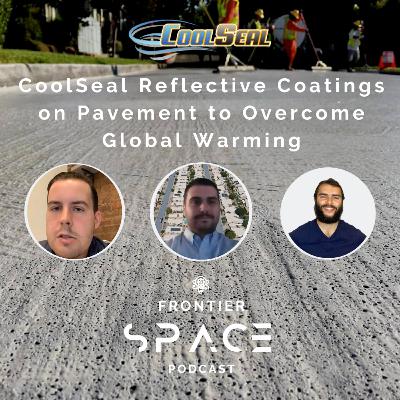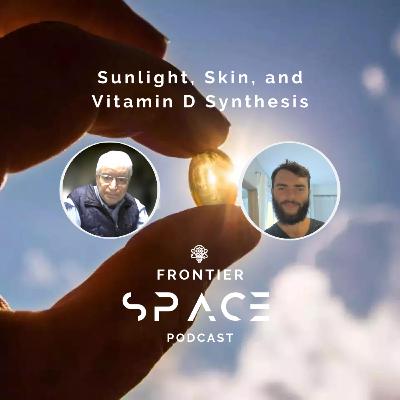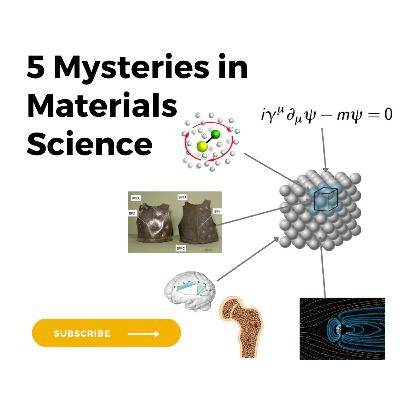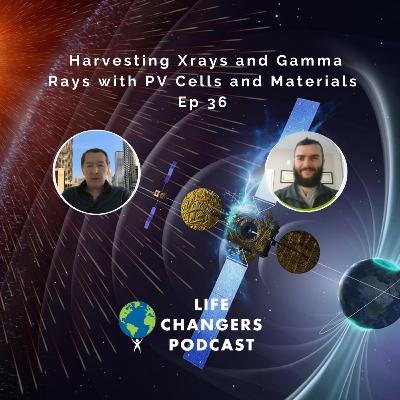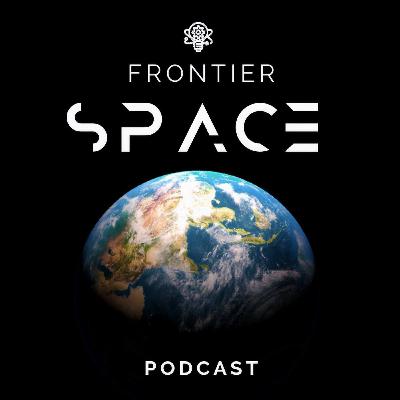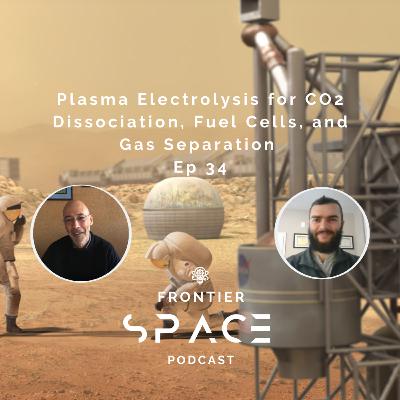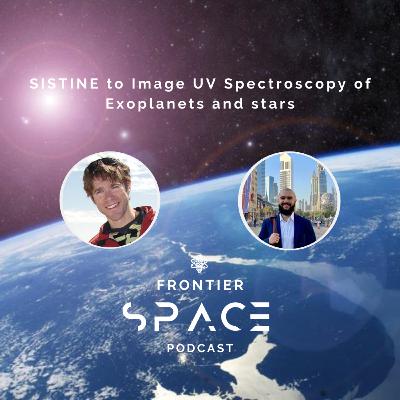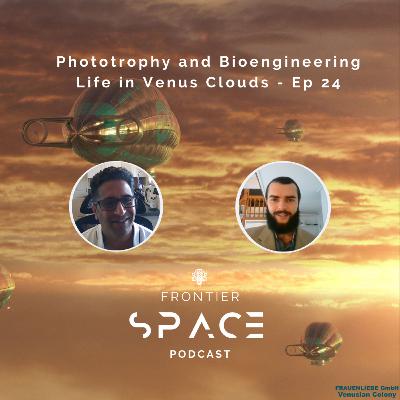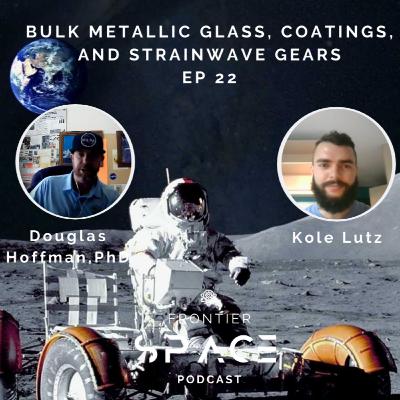Discover Frontier Space
Frontier Space

Frontier Space
Author: Kole Lutz
Subscribed: 12Played: 158Subscribe
Share
© Kole Lutz
Description
Frontier Space is a research organisation and podcast listened to in 80+ countries with entrepreneurs and researchers advancing engineering, climate action, materials science, biotechnology, and space systems. Our Podcast host Kole Lutz is the cofounder of startups such as Magneto Space. The Podcast helps push the envelope of science and development of life on Earth and beyond.
46 Episodes
Reverse
Explore GuardTop’s CoolSeal Reflective Coating to reflect 30% more sunlight, reduce asphalt surface temperatures by 10-25 degrees Fahrenheit, and save millions in thermal/energy costs. Dive into solar-activated engineered pigment, material properties, challenges such as UV light, microcracks, and also the environment/energy/cost savings, growth and potential to overcome global warming and cool planet Earth.
Speakers
Davis Koleas, Director of Sustainability,CoolSeal by GuardTop
Michael March, Director, Technical | Product Management, Research and Development, GuardTop
https://www.coolseal.com/
Learn about research,benefits, and significance from humans producing vitamin D from sunlight. Our guest Dr. Michael Hollick, who is considered to be the father of vitamin D, is responsible for creating a billion-dollar vitamin D sales market and testing juggernaut, shares his research and findings on Sunlight-induced Vitamin Synthesis.
Explore five mysteries in materials science, engineering and defects. Glimpse into emerging research projects as we gander into the world of nanoparticles and nanotechnology. This video was created from UVA's MSE 3060 Defects & Microstructures course.
Chapters:
0:00 Divacancies
1:33 Oxygen Vacancies
2:20 Armor Shield
3:00 Space & Crystal Lattice
4:13 Dark Matter antiparticles
Learn about Minimass from Andy Coward on the mission to create low-carbon, low-cost, 3d printed concrete beams with 78% reduction in concrete, and 50% reduction in material costs. Approach holds potential to 3D print any compression carrying material for buildings and bridges on Earth and beyond. Topics include: 3D printing with mortar in-situ, sawtooth beam design, materials science <2-10mm aggregates, and more.
Andy Coward of Net Zero Projects (NZP) Limited, holds a 1st class degree in Civil and Structural Engineering from the University of Cambridge and has over 15 years of experience in design and construction. Prior to inventing Minimass, he held senior positions at Bjarke Ingels Group in Copenhagen as director of engineering and at Foster + Partners in London as associate partner.
Learn about how lead Iodide perovskites (CH3Nh3PbI3) and thin-film cadmium telluride (CdTe) can be utilised for X ray and gamma voltaics. After researchers observed 75% charge collection efficiency with MAPbl3, Material shows less than 20% decrease in performance up to 40 Sv of Xray dose, demonstrating very good stability with a few on orbit demos. Topics include applications to collect ambient energy near reactors and soft X-ray background (SXRB/CXRB in 2-100keV).
Speaker:László Forró, Professor of Physics of Complex Quantum Matter, Notre Dame
2015 Study: Methylammonium Lead Iodide for Efficient X-ray Energy Conversion
https://pubs.acs.org/doi/full/10.1021/acs.jpcc.5b07876
Dive into underexplored ideas and questions in Top Engaging Tweets from Kole's Twitter in 2022.
https://twitter.com/kolelutz
Dive into Magnetohydrodynamic (MHD) simulations of the HD 189733 star-planet system in order to predict radio transit modulations of exoplanets. Learn how MHD simulations can model electromagnetic field interactions between local stars and exoplanet magnetospheres at varying planetary radii, and field intensities to generate synthetic radio images (10MHz-1GHz), EM field strength, viewing phase angles, and local star parameters.
Topics include: Alfven Wave Solar Atmosphere Model (AWSOM),ray tracing algorithm,Plasma Physics Absorption coefficient,imaging Modulated waves, spacebased instruments, Scar telescope mission, and future research with radio, EUV, and Xray transits to run algorithms on datasets to classify 1,000 Earth-sized planets within 50ly
Soumitra Hazra, Post-Doctoral Research Associate, Lowell Center for Space Science and Technology
Exoplanet Radio Transits as a Probe for Exoplanetary Magnetic Fields -- Time-dependent MHD Simulations
Soumitra Hazra, et al, 2022, Earth and Planetary Astrophysics, https://doi.org/10.48550/arXiv.2208.06006
Dive into plasmas for electrolysis, gas decomposition, climate change, and in situ resource utilization (ISRU) to produce oxygen, fuels, life support, and agriculture on Mars, Venus, Earth, and beyond. Lead author and speaker Vasco Guerra, from IST Uni de Lisboa shares team’s findings, journey, experiment results.
After testing in Martian composition & Pressure for CO2 decomposition, plasma enhanced solid oxide fuel cell (SOFC) comparable to MOXIE yields 14g of O2 /hr for P=250W with 5kg 25x20x5cm payload @3.5g O2 per hour per kg with 13lb plasma reactor, which is 1/3weight of MOXIE and 6X higher values. Topics include with Yttria reactor for ion conducting membrane, Dielectric barrier discharge (DBD) reactors, Fast ionisation waves(FIW), CO2 microwave plasma torch. Learn about how plasma can be utilised for gas conversion, static charge removal, thrusters for space propulsion, and many markets on Earth
Study on Plasmas for ISRU: Fuels, life support, and agriculture
https://doi.org/10.1063/5.0098011
Dive into Pod episode with Rogue Space systems and engineering, three on orbit servicing ‘orbots’ including: 19kg Laura Orbot with 1mm res radar/hyperspectral from 500-550m to measure space materials, debris, and rotational behaviour (yaw,pitch,roll), as well as Barry Orbot 1U Cubesat with 360deg 8x8MP imaging.
Topics include: vibrometer applications, Continuous scan laser Doppler vibrometry (CSLDV), surface material imaging, debris mitigation, down stream applications, coatings on orbit, in-space nanomaterial characterisation and 3D AM printing.
Speaker: Jeromy Grimmett, Rogue CEO and Founder
https://www.linkedin.com/in/jeromy-grimmett-85770041/
Learn about SISTINE missions with 5 min suborbital flight in Summer 2022 with Far UV imaging spectroscopy imaging 100k photons at 100 to 160 nm for emission lines associated with atmospheres of low mass stars and exoplanets. With advanced optical mechanical designs, this enables SISTINE to achieve high signal-to-noise observations of emission lines from planet-hosting dwarf stars with moderate spectral resolution (R ~ 10,000) and sub-arcsecond angular imaging. Topics include: exoplanet atmospheres, borosilicate microchannel plate detectors, al coating mirror, 1200lb mass, Alfvén waves , alpha centauri, UV Flux, atomic oxygen, and significance for discovering habitable exoplanets
Speaker: Kevin France PhD, Assistant Professor, Department of Astrophysical and. Planetary Sciences & LASP – University of Colorado.
The large-scale magnetic field of Proxima Centauri near activity maximum
https://arxiv.org/abs/2010.14311?context=astro-ph
Plunder in to explore takeaways with Alex Madurowicz from Stanford on his 2022 SGL Study below outlining the orbital mechanics, to send craft to Solar Gravitational Lens (SGL), how to maintain alignment with target planet and optical effects and sources of noise, and a special algorithm designed undistort the light by reversing the bending from the gravitational lens, which turns the Einstein ring back into a pixelated round planet. SGL telescopes can improve the precision of imaging of exoplanet surfaces by 1,000X.
Join us on a special edition to the farthest we have gone beyond Earth in an episode, to the Solar Gravitational Lens past 550 Astronomical units, 14X farther away than pluto-sun distance. Topics include Einstein ring, applications of microlensing, 1metre scale telescope demo to SGL by ~2030, radio beacon for interstellar comms and first contact.
Madurowicz, Alexander & Macintosh, Bruce. (2022). Integral field spectroscopy with the solar gravitational lens, Astrophysical Journal, May 2022.
https://doi.org/10.3847/1538-4357/ac5e9d
Additional Readings:
https://www.nasa.gov/directorates/spacetech/niac/2020_Phase_I_Phase_II/Direct_Multipixel_Imaging_and_Spectroscopy_of_an_Exoplanet/
Envisioning a life expanding solar system with high power orbital lasers (GEO or Lagrange) for uG transit with Dr. Young Bae, Founder of PTL and YK Bae Corp. Learn about advantages of Beam Laser Propulsion (BLP) and Photon Laser Thrusters (PLT) to achieve high delta V departure to launch cargo to nearby planets Mars and Venus within a few weeks and Earth to Moon in 14-20 hours. Topics include YAG laser, active resonant optical cavity, primary and secondary mirror, first cubesat laser beam ground 2008 demo, (Yb:YAG) thin-disk gain medium and network of high reflectance lightweight mirrors, laser/solar sails, and more !
https://ykbcorp.com/
First Demonstration of Photonic Laser Thruster (PLT), Proceedings of the High-Power Laser Ablation, SPIE, Taos, pp. 700510 (2008).https://www.researchgate.net/publication/265813101
Prospective of Photon Propulsion for Interstellar Flight, Physics Procedia, Vol. 38, pp. 253 – 279 (2012).https://www.researchgate.net/publication/268423813
https://www.researchgate.net/publication/347522562
https://www.youtube.com/watch?v=mRW2JZXA8wg
Explore the significance of sonocytology, atomic force microscopy (AFM), and other nanoprobes to measure the sounds/songs from the cell, abiotic matierals, and to bioengineer cells beyond Earth from AFM sound pioneer Dr. James Gimzewski, Distinguished Professor of Chemistry at the UCLA and Director of the Nano & Pico Characterization Core.
Topics include nanomechanical analysis of cells from cancer patients, quantifying intracellular frequencies, applications of AFM for eukaryotic/prokaryotic cells, piezoelectric actuators, data vibration/math acoustic analysis, microgravity (uG) experiments, and future research opportunities.
References
www.scienceabc.com/pure-sciences/how-do-our-cells-produce-sound.html
Cross, Sarah E et al. “Nanomechanical analysis of cells from cancer patients.” Nature nanotechnology vol. 2,12 (2007): 780-3.
https://doi.org/10.1038/nnano.2007.388
Kirmizis, Dimitrios, and Stergios Logothetidis. “Atomic force microscopy probing in the measurement of cell mechanics.” International journal of nanomedicine vol. 5 137-45. 7 Apr. 2010, doi:10.2147/ijn.s5787
Take a gander into acoustic analysis of laser-induced graphene (LIG) with our guest, John Li, PhD Candidate from Stanford University and pod host Kole Lutz. Researchers used a $31 microphone attached to the CO2 laser writing head, followed by a simple acoustic signal processing scheme that allows for far greater quality control capabilities that are orders of magnitude faster than characterization of laser-induced graphene by microscopy techniques.
By applying Fourier and integral analyses, reseachers observed the local quality and morphology of the produced material graphene. Learn about how the acoustic analysis and signal processing can evaluate material properties and synthesis with implications for a wide range of applications including sintering, phase engineering, strain engineering, chemical vapor deposition, combustion, annealing, laser-cutting, gas evolution, distillation, spacecraft, bioengineering, and more.
Li, V. D., Li, J. T., Beckham, J. L., Chen, W., Deng, B., Luong, D. X., Kittrell, C., Tour, J. M., Sounds of Synthesis: Acoustic Real-Time Analysis of Laser-Induced Graphene. Adv. Funct. Mater. 2022, 2110198. https://doi.org/10.1002/adfm.202110198
DATAQ Instruments Brand Data Loggers Model DI-1100, $50 data logger system with Windaq software. DATAQ Instruments' WinDaq Waveform Browser (WWB) playback software (FREE) contains a Fourier transform algorithm.
https://www.dataq.com/data-logger/dataq/
Dive into Masten Space’s near-instant landing pads called in-Flight Alumina Spray Technique (FAST) method with our guest Matthew Kuhns, VP R&D, to in-situ manufacture near-instant 6meter+ diameter landing pads with dust free zone.
In partnering with Texas A&M, UCF, and Honeybee Robotics and collaborating with a NASA NIAC Phase 1 program, Masten conducted a series of tests and experiments in 2021 on Earth using the High velocity oxygen thermal spraying (HVOF) concept to release .5 mm alumina ceramic powder nanoparticles from the rocket exhaust, to build up spray coating in lunar regolith, and to deploy a thin pad from 30m deployment height and prevent ejecta plume/debris.
Traditionally, each lunar landing pad was expected to cost $120 million and kick up high-velocity regolith that can travel up to 3,000+ meters per second. Learn about results from test flights on Earth simulating delivery of 300kg mass payload to Lunar surface, future research, material science, math, compressive strengths, dust debris mitigation, plume impingement analysis, pressure injection, localised melting/point stresses, future applications, and more.
researchgate.net/publication/356422803_FAST_Landing_Pads_for_Moon_and_Mars
masten.aero/blog/mitigating-lunar-dust-masten-completes-fast-landing-pad-study/
Speaker
Matthew Kuhns, VP R&D at Masten Space Systems
With over a decade of experience in aerospace and startups, Matthew has co-founded several companies. Matthew plays key roles around technology development and advanced concepts, holding 5 patents and the title NASA NIAC Fellow. He is a leader in enabling technologies including LOX/Methane propulsion systems, electric pumps, and advanced additive manufacturing.
Masten Space Systems is a aerospace R&D and Earth and Moon transportation company creating and deploying reliable, reusable rocket vehicles and components. Because landing on the Moon, Mars, or anywhere else in the solar system is what Masten Space Systems can do for you. With more than 600 successful rocket-powered landings, 17 years of business and 5 rocket platforms, Masten puts landers and payloads right where they need to be every time.
Dive into straintronics and mechanical kinks (nanocurtains or or nano-speed bumps) with 2D sheet graphene.Similar to nano-origami, deformed 2D sheet graphene altered material's electronic and mechanical properties and accidentally created the tiniest microchips ever. Adding up to 1% wt of graphene sheets or GOx could make carbon fiber 225% stronger and 184% stiffer. Learn about the applications including highly-sensitive cancer biosensors, advanced water filters, and next-generation energy storage battery parts. Straintronics can increase the amount of transistors inside microchips by 5-6X to make computers, phones, and devices 1,000X faster and Increase time duration of nanorobots and gears by up to 10X.
Tripathi, Manoj et al. “Structural Defects Modulate Electronic and Nanomechanical Properties of 2D Materials.” ACS nano vol. 15,2 (2021): 2520-2531. https://doi.org/10.1021/acsnano.0c06701
Investigating potential phototrophy, habitability, and bioengineering of microbes and potential floating algae in the lower, middle, and upper cloud layers of Venus with our guest, Rakesh Mogul, Ph.D., Professor of Biological Chemistry and Director; NASA/CSU Spaceward Bound, California State Polytechnic University, Pomona. Professor Rakesh recently published a study outlined below in finding that sunlight filtering through Venus’ clouds could support Earth-like photosynthesis round-the-clock in Venus’ clouds with the middle and lower clouds receiving similar solar energy as Earth’s surface.
Mogul R, Limaye SS, Lee YJ, Pasillas M. Potential for Phototrophy in Venus' Clouds. Astrobiology. October, 2021;21(10):1237-1249. https://doi.org/10.1089/ast.2021.0032
Professor Rakesh's Website:
https://www.cpp.edu/~rmogul/home.html
Discussion/topics include:
Part 1: Phototrophy and Habitability in Venus Clouds
Bacterial chlorophyll B, floating algal blooms, cloud chemistry, photophysical/chemical/biological habitability, hammett acidity factor, bioavailable water activity level, neutralized sulfuric acid favor a habitable zone, solar irradiances for photosynthesis, primary biological aerosol particles (PBAP), NASA 1kg Aircraft Bioaerosol Collector (ABC), airborne microbial metabolism and spores up to 38km in Earth's clouds, mitosis cell division in clouds
Part 2: Bioengineering
Investigating how to apply the following systems to adapt microbial life to local conditions in Venus clouds: Venus sulfuric acid (H2SO4) coatings, airborne DNA sequencers, Bioengineering Whispering gallery mode (WGM) phycobilliproteins, biophotonic Optofluidic Microcavities Liquid Crystal Droplets, introducing an enzyme into the water to increase H production by 400%, UV resistant nanostructured coatings and biofouling hydrophilic coatings, self replicating algae mats and floating algae ISRU bioreactors in clouds of Venus
A lively dialogue on the mission, design, and implications of SuperBIT balloon-borne telescope one of the highest resolution telescopes ever made with our guest Barth Netterfield PhD, Professor, DADDAA & Physics at Uni of Toronto and project lead of SuperBIT mission to image weak gravitational lensing, galactic star formation, distribution and quantity of dark matter in galaxy clusters and super exoplanet atmospheres.
The $5M Super-pressure Balloon-borne Imaging Telescope (SuperBIT) is 1,300X lower than the cost of the $6.5bn Hubble Space Telescope to image visible-to-near-UV (300-900 um) with 0.25-.5 arc second imaging and 50X more sensitive resolution than hubble. With a 0.5 m mirror, wide-field, 1.5m aperture, SuperBIT is equipped a helium balloon and 80kg carbon fiber mount telescope with a 69-megapixel camera with low read noise, high quantum efficiency and very low dark current that is capable of flying 1,000kg science payload at 35km altitude. Toward the end of the Podcast episode, Barth enlightens us about the preliminary plans and implications of GigaBIT, next generation atmospheric telescope focusing on green, blue and UV imaging wavelengths, which is planned to be 4X better than ground telescopes with 3X imaging stability over superbit potential launch in late 2020's
SuperBIT: A low-cost, balloon-borne telescope to rival Hubble
https://phys.org/news/2021-07-superbit-low-cost-balloon-borne-telescope-rival.html
_________________________________________________________________________________________________________
Romualdez, L. J., et al (2018). Overview, design, and flight results from SuperBIT: A high-resolution, wide-field, visible-to-near-UV balloon-borne astronomical telescope. In L. Simard, L. Simard, C. J. Evans, & H. Takami (Eds.), Ground-based and Airborne Instrumentation for Astronomy VII [107020R] (Proceedings of SPIE - The International Society for Optical Engineering; Vol. 10702). SPIE. https://doi.org/10.1117/12.2307754
Chime into the edge of materials science, manufacturing, and applications of amorphous metals, or metallic glass with Doug Hoffman, PhD, Founder of Metallurgy Facility, Cofounder of Materials Development and Manufacturing Technology Group and Additive Manufacturing Center at NASA’s Jet Propulsion Laboratory.
Learn about the material properties of amorphous metals to operate systems and robotics in conditions with high hardness, corrosion resistance, bouncy property, high abrasive, dusty and cryogenic extreme environments. Explore how low cost high performance BMG strainwave gears can reduce robotic arms cost by 50%, significantly improve cost, energy, and science for robotic operations on Earth, Moon, Mars, and beyond.
The launch of FS Pod Season 2 explores how Bulk metallic glass (BMG), coatings, and strainwave gears are disrupting robotics, spacecraft, solar panel deployment, antenna positioning, in space & bimetallic 3D printing, automotive parts, food industry, and bioengineering.
The African Union passed legislation to establish the African Space Agency in 2017 and recently approved Egypt as host country for the headquarters of the new agency. Tune into this month's episode to dive into the founding, launch, and development of the African Space Agency (AfSA) with our guest Ayman Ahmed, PhD, Head of Space Imaging & BoD at Egyptian Space Agency. Learn about the objectives, missions, satellite project, involvement of the Egyptian Space Agency, African Union, and government, human space flight program, potential fellowship/exchange program, and how to get involved!


